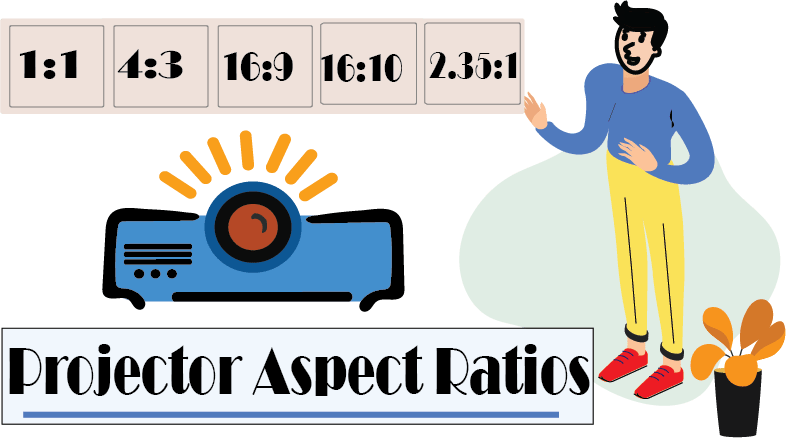Today will be your lucky day as I’ll share some of the common projector aspect ratios with you.

Do you know how you get those annoying rectangular black bars that boxes in the image being projected on your projector screen?
Truth be told, selecting a suitable projector screen size may provide you with an excellent image quality during your Netflix and chill.
But to get the best viewing experience, you would have to consider some projector specifications, one of which is the aspect ratio of the projector.
Definition of an Aspect Ratio of a Projector
The aspect ratio is the relationship between the width and the height of the image projected on the screen.
For instance, if your new projector screen has a width of 40 inches and a height of 30 inches.
Then, the aspect ratio will be 40/30. Otherwise stated as 4/3 but mostly as 4:3.
Therefore, the aspect ratio of a projector shows the relationship of the horizontal (width) and vertical (height) dimensions of the display and not the screen’s size.
Based on whatever the aspect ratio is, the images projected by the projector usually appear either square or rectangular shaped.
Also, the aspect ratio of any projector is constant regardless of the size of the image. It will not change even if the projector projects images of 100 inches or 140 inches.
The Best Aspect Ratios for Projector
There are a few standard aspect ratios for projectors.
- 1:1 (Squared screens)
- 4:3 (Standard Format or NTSC)
- 16:9 (HD Format)
- 16:10 (Wide-screen Format)
- 2.35:1 to 2.40:1 (Cinemascope Format)
1:1 (Squared screens)
Projectors with squared screens or 1:1 are often in educational and research facilities to help project slides and make presentations.
These projectors, such as the overhead projectors, are best to use in this case since they have matching aspect ratios with the screen.
These squared screens simulate an HDTV (High Definition TV) or wide-screen viewing when rolled up or down.
4:3 (Standard Format or NTSC)
Most projectors in the older projector technology had an aspect ratio of 4:3 primarily made with the consideration of what businesses require.
Home projectors and computer monitors are in the same aspect ratio as the original television format based on their design.
However, in recent times, the standard quality of home and business projectors’ display has become the Full High Definition.
With the quality of the content continually improving, projectors are moving to have a 16: 9 aspect ratio. Although, a few business projectors are still of 4:3 aspect ratio till today.
16:9 (HD Format)
With the standard format (4:3) gradually phasing out, the 16:9 aspect ratio has become very popular for modern projectors. Since introducing the HDTV (High Definition Television) to the market, 16:9 has become a widely adopted standard.
Game consoles, DVD players, and other modern gadgets produce an output with a 16:9 resolution. Hence, a 16:9 aspect ratio can only be ideal for watching Full HD (1080p) content.
16:10 (Wide-screen Format)
Only a few projectors have an aspect ratio of 16:10. You will rarely find such projectors in homes, but more often in businesses. Also, a few laptops and monitors used in offices have the same aspect ratio of 16:10.
Therefore, projectors with a 16:10 aspect ratio are less common in the market than those with 16:9. Also, displays with 16:10 resolution are limited as compared to those with 16:9 resolution.
2.35:1 to 2.40:1 (Cinemascope Format)
You will find the projectors with the cinemascope format most frequently in screens used in the cinemas.
Based on different manufacturers, they can come in aspect ratios of 2.35:1, 2.39:1, or 2.40:1.
These projectors are ideal for presentations. If your gadget can play media in cinemascope format, you would enjoy the cinema-like experience.
Moreover, several movies produced are in cinemascope format, hence makes these projectors suitable for watching movies.
How to Choose the Best Aspect Ratio for Projectors?
Before you can select the correct aspect ratio for your projector, there are certain factors to consider. Using these factors takes away the stress of choosing the projector with the wrong aspect ratio. That can be frustrating, though. With some of the recommended steps here, it will be easier to locate the projector with the correct aspect ratio.
First, find out the aspect ratio of the content that the projector will display.
Is it 16:10 or 16:9 or perhaps 4:3?
For instance, most home theatres use a 16:9 projector with their media players (example: DVD players) producing images in 16:9 format as their output.
However, If your media playing device is compatible with a different aspect ratio, then go for the projector with the same aspect ratio as the media player.
Next, are projectors used mainly for presentations. They are the 4:3 projectors. You can locate these projectors in offices and places of worship.
The 4.3 projectors are the best choice of projectors to make if you intend to use them for presentations. They are also relatively cheaper than other projectors.
Then, if your reason for getting a projector is majorly to enjoy your favorite shows and movies, consider a projector with an aspect ratio of 2.40:1.
Moreover, such projectors are the best for seeing movies because most of the movies these days are in the cinemascope format.
Conclusion
One more thing you should know about choosing the best aspect ratios. It is perfect to use projectors of an aspect ratio the same as the media playing devices used.
Projectors can project images with a different aspect ratio. Therefore, when you use a projector with an aspect ratio of 16:9 to project images or videos in 4:3 format, you would see black bars appear on the projection sides.
Whereas black bars will appear on the top and bottom of the projected images or videos (with an aspect ratio of 4.3) when you use a projector with an aspect ratio of 16:10 or 16:9. But using a 16:9 projector to project a 4:3 or 16:10 content, it is more desirable because it limits the black sections around the projected images and videos.
Finally, after reading this article, you should properly select the projector with the best aspect ratio.

